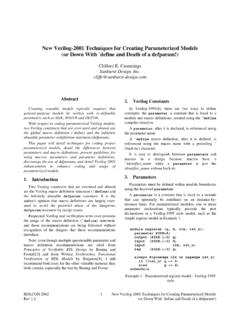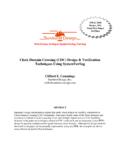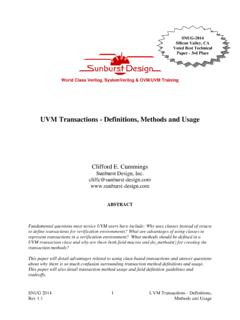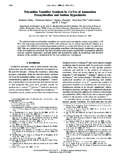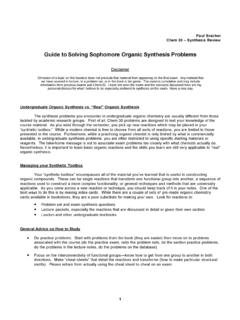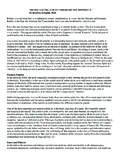Transcription of Simulation and Synthesis Techniques for Asynchronous FIFO ...
1 Expert Verilog, SystemVerilog & Synthesis TrainingSimulation and Synthesis Techniques for AsynchronousFIFO Design with Asynchronous Pointer ComparisonsClifford E. CummingsPeter AlfkeSunburst Design, , interesting technique for doing fifo design is to perform Asynchronous comparisons between the fifo writeand read pointers that are generated in clock domains that are Asynchronous to each other. The Asynchronous fifo pointer comparison technique uses fewer synchronization flip-flops to build the fifo . The Asynchronous fifo comparison method requires additional Techniques to correctly synthesize and analyze the design, which are detailedin this increase the speed of the fifo , this design uses combined binary/Gray counters that take advantage of the built-in binary ripple carry fully coded, synthesized and analyzed RTL Verilog model ( fifo Style #2) is fifo design paper builds on information already presented in another fifo design paper where the fifo pointers are synchronized into the opposite clock domain before running " fifo full" or " fifo empty" tests.
2 Thereader may benefit from first reviewing the fifo Style #1 method before proceeding to this fifo Style #2 Editorial Comment (by Cliff Cummings)Although this paper was voted Best Paper - 1st Place by SNUG attendees, this paper builds off of a second fifo paper listed as reference [1]. The first fifo paper laid the foundation for some of the content of this paper;therefore, it is highly recommended that readers download and read the FIFO1 paper[1] to acquire backgroundinformation already assumed to be known by the reader of this Jose, CAVoted Best Paper1st PlaceSNUG San Jose 2002 Simulation and Synthesis Techniques for AsynchronousRev Design with Asynchronous Pointer IntroductionAn Asynchronous fifo refers to a fifo design where data values are written sequentially into a fifo buffer usingone clock domain, and the data values are sequentially read from the same fifo buffer using another clock domain,where the two clock domains are Asynchronous to each common technique for designing an Asynchronous fifo is to use Gray[4] code pointers that are synchronizedinto the opposite clock domain before generating synchronous fifo full or empty status signals[1].
3 An interestingand different approach to fifo full and empty generation is to do an Asynchronous comparison of the pointers andthen asynchronously set the full or empty status bits[6].This paper discusses the fifo design style with Asynchronous pointer comparison and Asynchronous full and emptygeneration. Important details relating to this style of Asynchronous fifo design are included. The fifo styleimplemented in this paper uses efficient Gray code counters, whose implementation is described in the next Gray code counter - style #2 One Gray code counter style uses a single set of flip-flops as the Gray code register with accompanying Gray-to-binary conversion, binary increment, and binary-to-Gray conversion[1].A second Gray code counter style, the one described in this paper, uses two sets of registers, one a binary counterand a second to capture a binary-to-Gray converted value.
4 The intent of this Gray code counter style #2 is to utilizethe binary carry structure, simplify the Gray-to-binary conversion; reduce combinational logic, and increase theupper frequency limit of the Gray code binary counter conditionally increments the binary value, which is passed to both the inputs of the binarycounter as the next-binary-count value, and is also passed to the simple binary-to-Gray conversion logic, consistingof one 2-input XOR gate per bit position. The converted binary value is the next Gray-count value and drives theGray code register 1 shows the block diagram for an n-bit Gray code counter (style #2).Figure 1 - Dual n-bit Gray code counter style #2 SNUG San Jose 2002 Simulation and Synthesis Techniques for AsynchronousRev Design with Asynchronous Pointer Comparisons3 This implementation requires twice the number of flip-flops, but reduces the combinatorial logic and can operate ata higher frequency.
5 In FPGA designs, availability of extra flip-flops is rarely a problem since FPGAs typicallycontain far more flip-flops than any design will ever use. In FPGA designs, reducing the amount of combinationallogic frequently translates into significant improvements in ptr output of the block diagram in Figure 1 is an n-bit Gray code : since the MSB of a binary sequence is equal to the MSB of a Gray code sequence, this design can be furthersimplified by using the binary MSB-flip-flop as the Gray code MSB-flip-flop. The Verilog code in this paper didnot implement this additional optimization. This would save one flip-flop per Full & empty detectionAs with any fifo design, correct implementation of full and empty is the most difficult part of the are two problems with the generation of full and empty:First, both full and empty are indicated by the fact that the read and write pointers are identical.
6 Therefore,something else has to distinguish between full and empty. One known solution to this problem appends an extra bitto both pointers and then compares the extra bit for equality (for fifo empty) or inequality (for fifo full), alongwith equality of the other read and write pointer bits[1].Another solution, the one described in this paper, divides the address space into four quadrants and decodes the twoMSBs of the two counters to determine whether the fifo was going full or going empty at the time the two pointersbecame 2 - fifo is going full because the wptr trails the rptr by one quadrantIf the write pointer is one quadrant behind the read pointer, this indicates a "possibly going full" situation as shownin Figure 2. When this condition occurs, the direction latch of Figure 4 is San Jose 2002 Simulation and Synthesis Techniques for AsynchronousRev Design with Asynchronous Pointer Comparisons4 Figure 3 - fifo is going empty because the rptr trails the wptr by one quadrantIf the write pointer is one quadrant ahead of the read pointer, this indicates a "possibly going empty" situation asshown in Figure 3.
7 When this condition occurs, the direction latch of Figure 4 is 4 - fifo direction quadrant detection circuitryWhen the fifo is reset the direction latch is also cleared to indicate that the fifo is going empty (actually, itis empty when both pointers are reset). Setting and resetting the direction latch is not timing-critical, and thedirection latch eliminates the ambiguity of the address identity San Jose 2002 Simulation and Synthesis Techniques for AsynchronousRev Design with Asynchronous Pointer Comparisons5 The Xilinx FPGA logic to implement the decoding of the two wptr MSBs and the two rptr MSBs is easilyimplemented as two 4-input look-up second, and more difficult, problem stems from the Asynchronous nature of the write and read two counters that are clocked asynchronously can lead to unreliable decoding spikes when either or bothcounters change multiple bits more or less simultaneously.
8 The solution described in this paper uses a Gray countsequence, where only one bit changes from any count to the next. Any decoder or comparator will then switch onlyfrom one valid output to the next one, with no danger of spurious decoding fifo style #2 For the purposes of this paper, fifo style #1 refers to a fifo implementation style that synchronizes pointers fromone clock domain to another before generating full and empty flags [1].The fifo style described in this paper ( fifo style #2) does Asynchronous comparison between Gray code pointersto generate an Asynchronous control signal to set and reset the full and empty block diagram for fifo style #2 is shown in Figure 5 - FIFO2 partitioning with Asynchronous pointer comparison logicTo facilitate static timing analysis of the style #2 fifo design, the design has been partitioned into the followingfive Verilog modules with the following functionality and clock domains: - (see Example 1 in section ) - this is the top-level wrapper-module that includes all clockdomains.
9 The top module is only used as a wrapper to instantiate all of the other fifo modules used in thedesign. If this fifo is used as part of a larger ASIC or FPGA design, this top-level wrapper would probably bediscarded to permit grouping of the other fifo modules into their respective clock domains for improvedsynthesis and static timing San Jose 2002 Simulation and Synthesis Techniques for AsynchronousRev Design with Asynchronous Pointer Comparisons6 - (see Example 2 in section ) - this is the fifo memory buffer that is accessed by both thewrite and read clock domains. This buffer is most likely an instantiated, synchronous dual-port RAM. Othermemory styles can be adapted to function as the fifo buffer. - (see Example 3 in section ) - this is an Asynchronous pointer-comparison module that isused to generate signals that control assertion of the Asynchronous full and empty status bits.
10 This moduleonly contains combinational comparison logic. No sequential logic is included in this module. - (see Example 4 in section ) - this module is mostly synchronous to the read-clockdomain and contains the fifo read pointer and empty-flag logic. Assertion of the aempty_n signal (an inputto this module) is synchronous to the rclk-domain, since aempty_n can only be asserted when the rptrincremented, but de-assertion of the aempty_n signal happens when the wptr increments, which isasynchronous to rclk. - (see Example 5 in section ) - this module is mostly synchronous to the write-clock domainand contains the fifo write pointer and full-flag logic. Assertion of the afull_n signal (an input to thismodule) is synchronous to the wclk-domain, since afull_n can only be asserted when the wptrincremented (and wrst_n), but de-assertion of the afull_n signal happens when the rptr increments,which is Asynchronous to San Jose 2002 Simulation and Synthesis Techniques for AsynchronousRev Design with Asynchronous Pointer RTL code for fifo style #2 The Verilog RTL code for the fifo style #2 model is listed in this - fifo top-level moduleThe fifo2 top-level module is a parameterized module with all sub-blocks instantiated following safe codingpractices using named port fifo2 (rdata, wfull, rempty, wdata, winc, wclk, wrst_n, rinc, rclk, rrst_n); parameter DSIZE = 8; parameter ASIZE = 4; output [DSIZE-1:0] rdata; output wfull; output rempty.


